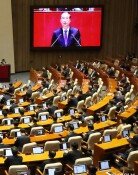Hospital interns abandon internship programs amid crisis
Hospital interns abandon internship programs amid crisis
Posted February. 26, 2024 07:57,
Updated February. 26, 2024 07:57
A large number of medical school graduates are refusing to begin their internships at university hospitals amidst the widening gap in medical care, caused by the walkouts of interns and residents from hospitals on Tuesday. With a significant number of third- and fourth-year residents and fellow doctors expected to depart from hospitals, the inability to recruit new interns has heightened the likelihood of the "March medical crisis," where the number of surgeries in large hospitals could drop to less than 10% of previous levels, becoming a reality.
According to the medical community on Sunday, there have been a number of cases of interns who were accepted at university hospitals across the country giving up their internships en masse.
“Most of the 123 interns who applied for the internship program have announced their intention to terminate their contracts,” an official from Samsung Medical Center said. At Pusan National University Hospital, 52 of the 57 interns scheduled to begin work next month have submitted resignation documents. Similarly, all 36 interns slated to commence training at Chosun University Hospital have abandoned their internship programs. The university hospitals, which had been attempting to fill the staffing gaps with new interns amidst the walkouts of junior doctors, now face deepening concerns.
Typically, university hospitals employ ‘new doctors’ who have passed the Korean National Medical Licensing Examination and enroll them in internship programs lasting one year, starting in early March. Subsequently, they select a specialty and serve as residents for three or four years before advancing to fellow doctors. The issue arises with the contracts of third- and fourth-year residents who remain at the hospital to complete their training, which also conclude either at the end of this month or early next month. Additionally, many fellow doctors, contracted on a yearly basis, also see their contracts ending around the same time. “Professors and fellow doctors are stepping in to cover the gaps left by junior doctors, but the departure of senior residents and fellows, combined with the challenge of recruiting interns, poses significant difficulties for hospitals,” said an official from a large hospital.
Despite an impending medical crisis, the government and doctors' organizations continue to engage in power struggles. The Ministry of Education plans to collect desired enrollment figures from 40 medical schools by next Monday and then promptly finalize the allocation to solidify the planned increase of 2,000 seats. In a related public statement, the ministry instructed medical schools to base their enrollment figures on previous submission data, aiming to maintain the increase submitted last year (totaling 2,251 to 2,847). After asserting that the increase in medical school enrollment should be re-evaluated from the beginning during a meeting of doctors' representatives on Sunday, the Korean Medical Association (KMA) marched to the Yongsan presidential office on Sunday.
The controversy over the expansion of medical school enrollment has also spread to the political sphere. Democratic Party leader Lee Jae-myung stated on Facebook that the right size for enrollment in medical schools is 400 to 500 students and that doctors should stop striking and the government should cease its show of suppression. In response, a senior official from the presidential office criticized Lee’s actions in a phone call with The Dong-A Ilbo, labeling it "an unacceptable attempt to provoke a political conflict" and "a maneuver to evade the party's internal crisis.”
이지운 easy@donga.com







